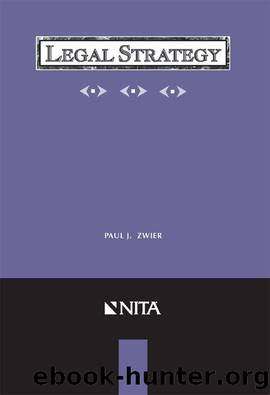Legal Strategy (NITA) by Paul J. Zwier

Author:Paul J. Zwier [Zwier, Paul J.]
Language: eng
Format: azw3
Publisher: Wolters Kluwer
Published: 2015-11-14T16:00:00+00:00
4.2 Model Code and Model Rules
While the Model is clear under Canon 7 regarding the lawyerâs obligation to represent the clientâs objectives zealously, it left to the Ethical Considerations the question of who controls what. EC 7-7 reads:
In certain areas of legal representation not affecting the merits of the cause or substantially prejudicing the rights of a client, a lawyer is entitled to make decisions on his own. But otherwise, the authority to make decisions is exclusively that of the client, and if made within the framework of the law, such decisions are binding on his lawyer.
The same Ethical Consideration describes settlement offers, affirmative defenses, and pleas as examples of what the client controls. While not in the form of a Disciplinary Rule, the Code places the ultimate decision making power with the client. The Codeâs position is consistent with general agency principles that the agent must act in the best interests of the principal. Presumably the best interests of the principal are best determined by the principal herself.
The Model Rules clear up any potential ambiguity over whether the Ethical Consideration was meant to be mandatory with Rule 1.2 (a), which provides a new twist:
(a) A Lawyer shall abide by a clientâs decisions concerning the objectives of representation, subject to paragraphs (c), (d) and (e) [(c) deals with the lawyerâs ability to limit clientâs objectives after consent with consultation; (d) deals with the lawyerâs inability to consult with regard to criminal or fraudulent activity; (e) deals with the lawyerâs inability to assist the client with conduct in violation of rules of professional conduct or contrary to law] and shall consult with the client as to the means by which they are to be pursued. (Emphasis added.)
Model Rule 1.2 is remarkable for the obligation it places on the lawyer with regard to counseling, including selecting counseling means to be pursued. It forces the lawyer to consult with the client both as to ends and means, and subjects the lawyer to discipline for failing to do so.
Before getting to the means issue in litigation, the conflict within Model Rule 1.2 itself must be discussed. Model Rule 1.2 (d) provides the countervailing pressure:
A lawyer shall not counsel a client to engage, or assist a client, in conduct that the lawyer knows is criminal or fraudulent, but a lawyer may discuss the legal consequences of any proposed course of conduct with a client, and may counsel or assist a client to make a good faith effort to determine the validity, scope, meaning or application of the law.
One of the most difficult aspects of 1.2(d) is defining âcounselingâ or âassisting.â The lawyer is told that he can discuss the legal consequences of proposed courses of conduct, but that he canât counsel or assist the illegal conduct. How can a lawyer provide the client information without assisting him to commit an illegal act?
Comment 2 to the Model Rule gives only this guidance:
A lawyer is required to give an honest opinion about the actual consequences that appear likely to result from a clientâs conduct.
Download
This site does not store any files on its server. We only index and link to content provided by other sites. Please contact the content providers to delete copyright contents if any and email us, we'll remove relevant links or contents immediately.
Master of the Game by Sidney Sheldon(1881)
GRE Premier 2017 with 6 Practice Tests by Kaplan(1503)
Law School Essays that Made a Difference by Princeton Review(1466)
Law: A Very Short Introduction by Raymond Wacks(1383)
A Life of Crime by Harry Ognall(1381)
Objection! by Nancy Grace(1330)
Examples & Explanations: Administrative Law by William F. Funk & Richard H. Seamon(1326)
Philosophy of law a very short introduction by Raymond Wacks(1297)
Writing to Win: The Legal Writer by Steven D. Stark(1279)
College Essays that Made a Difference by Princeton Review(1265)
Cracking the SAT Premium Edition with 6 Practice Tests, 2017 by Princeton Review(1252)
Sidney Sheldon (1982) Master Of The Game by Sidney Sheldon(1189)
GMAT For Dummies by Lisa Zimmer Hatch & Scott A. Hatch(1188)
Civil Procedure (Aspen Casebooks) by Stephen C. Yeazell(1175)
Drafting Contracts: How and Why Lawyers Do What They Do, Second Edition by Stark Tina L(1171)
Graduate Admissions Essays, Fourth Edition: Write Your Way into the Graduate School of Your Choice by Donald Asher(1138)
Storytelling for Lawyers by Meyer Philip(1136)
So You Want to be a Lawyer by Lisa Fairchild Jones Esq(1096)
INDEFENSIBLE: One Lawyer's Journey Into the Inferno of American Justice by Feige David(1010)
